[2022 Vehicle Displays] Desay sv
#Desay #automotive #display

https://ubiresearch.com/en/

https://en.olednet.com/

marketing@ubiresearch.com
+82-2-577-4391
#Desay #automotive #display

https://ubiresearch.com/en/

https://en.olednet.com/

marketing@ubiresearch.com
+82-2-577-4391
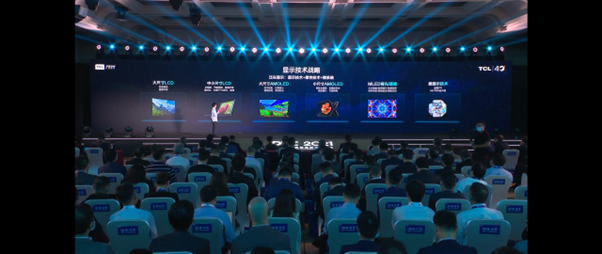
<Display technology strategy announced by TCL CSOT at DTC 2021>
According to the China Trend Report published by UBI Research, the schedules of TCL CSOT’s 8.5G LCD line T9 and 6G LCD line T5 are expected to be delayed.
In early July, the T9-1 was put into operation, but overall equipment orders for the ph-2 were delayed. According to the report, the schedule is expected to be delayed by about six months.
The schedule of the T5 line is expected to be postponed indefinitely. The T5 line was expected to begin mass production in the second half of 2023, but the schedule is indefinitely postponed and the mass production schedule is also uncertain.
Accordingly, TCL Chairman Li Dong Sheng, who is scheduled to visit Korea at the end of July, is expected to seek the understanding of Korean equipment makers due to the delay of schedules for LCD lines as well as consultations due to Samsung Electronics’ decrease in TV panel volume.
After visiting Korea, he is expected to visit JOLED in Japan to check inkjet technology. According to this visit, it is expected that the outline of whether the T8 line will be applied with inkjet process or deposition technology will be revealed in the future.
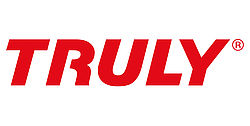
31 July 2017 – FlexEnable, the leader in the development and industrialization of organic electronics for flexible displays and sensors, has signed a technology transfer and license agreement with Truly Semiconductors, one of the leading display makers in China. The deal aims to bring FlexEnable’s flexible organic liquid crystal display (OLCD) technology into mass production on Truly’s lines within 2018.
Due to its high performance and low cost manufacturing process, OLCD is the only display technology today that can deliver flexible displays with large area, low cost and high brightness with long lifetime. With a bend radius that can go below 20 millimeters, OLCD meets the market needs for a range of applications across consumer electronics, smart home appliances, automotive, digital signage and beyond.
OLCD is based upon FlexEnable’s flexible low temperature organic thin-film transistor (OTFT) backplane technology, which can be manufactured on existing TFT LCD production lines using low cost plastic substrates such as TAC and PET. The OTFT backplane has better electrical performance than amorphous silicon, giving plastic LCDs the same display quality and reliability as glass-based LCDs, while making it thinner, lighter, shatterproof and conformable to surfaces.
Truly, the first display manufacturer to adopt OLCD, will implement the process into its existing production lines in Shanwei, China. The first product samples will be available to commercial partners in early 2018, with volume production expected in late 2018.
Chuck Milligan, CEO of FlexEnable, says, “Truly is a leader in displays manufacturing and a top-level supplier of displays to key market segments to which FlexEnable’s technology can bring great commercial advantages. We are already working with brands who use OLCD in their product concepts and who now need access to a volume supply chain to realize some very exciting new product offerings with designs that simply aren’t possible with other types of display. We are excited that Truly has become the first display manufacturer to implement FlexEnable’s game-changing OLCD platform and meet market demand for flexible displays.”
KK Ho, General Manager, R&D center, Truly Semiconductors Ltd, says, ”FlexEnable’s OLCD technology is a breakthrough in the TFT-LCD industry and with its characteristics of thinness, lightweight, and more durability it is going to create lots of possibilities for innovative product design. We have been receiving many enquiries for flexible display from the market, specifically, wearable devices, smart home appliances, electric cars and self-driving cars etc. This is a pretty exciting display technology and we do believe there is a considerable potential market size.”

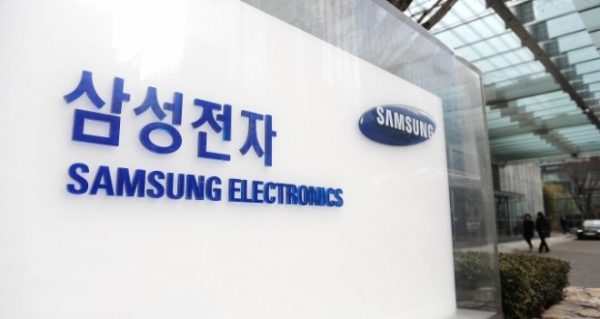
Samsung Electronics announced that it reached sales of 61 trillion Korean won and operating profit of 14.07 trillion Korean won, and the display business recorded 7.71 trillion won and operating profit of 1.71 trillion won, through the Q2 2017 Earnings Conference Call on 27th. Its display business has recorded more than 1 trillion won in the black, for 4 consecutive quarters since Q3 2016.
According to Samsung Electronics, its earnings for Q2 2017 has increased compared to the previous quarter due to the expanded sales of flexible OLED panels and high value-added LCD products.
The OLED division saw its earnings improvement on the back of flexible products sales increase due to the expanded sales of major customer flagship models, and accounted for low 60% of sales. The LCD division also improved earnings by expanding the sales of high value-added products, mainly UHD and large TVs.
The OLED division is expected to see sales growth for the second quarter of this year due to the expanded supply of flexible products compared to the last quarter. However, there will be fiercer competition with LTPS LCD in the mid to low-end market and a risk of cost increase resulting from ramp-up of new capacity lines. Accordingly, Samsung plans to improve profitability by aggressively responding to major customer demand through stable ramp-up of new lines and improving product mix.
The LCD division is anticipated to be in a supply-demand imbalance due to set companies’ stock increase of panels and panel suppliers’ supply expansion, but premium TVs such as high resolution and super-size TVs are expected to continue to grow. Samsung has a plan to increase profitability by promoting yield and cost improvement activities and by expanding the sales of not only high value-added products such as UHD and large-size products but also differentiated design products such as frameless and curved products.
Samsung Electronics recorded sales of 93 million mobile phones and 6 million tablets in Q2 2017, and in the third quarter, the sales of mobile phones and tables are likely to increase slightly and remain flat, respectively quarter on quarter. The sales volume of LCD TVs is expected to reach 9 million units and grow at low single in the third quarter.
Samsung Electronics invested a total of 12.7 trillion KRW in its facilities in the second quarter, of which 4.5 trillion KRW were invested in the display. This year’s investment plan for facilities is yet to be determined, but investment is expected to increase substantially from last year, especially for semiconductors and displays. The display division plans to invest in production expansion to meet the increasing demand for flexible OLEDs.
Director Lee Chang-hoon of Samsung Display said, “The smartphone set makers’ OLED adoption will continue to increase with the constant strong demand for it. The current OLED line is being resiliently operated in line with market and customer needs”. He added “We will continue to use and operate OLED lines strategically in accordance with market demand and customer needs.”, and explained they are not considering the plan to further shift LCD lines into OLED.
The seminar on the trend of the up-to-date technology for the next generation display which was themed ‘The technology trend for latest display and the automotive display’ hosted by the UBI Research, was held on July 14th at COEX in Seoul.
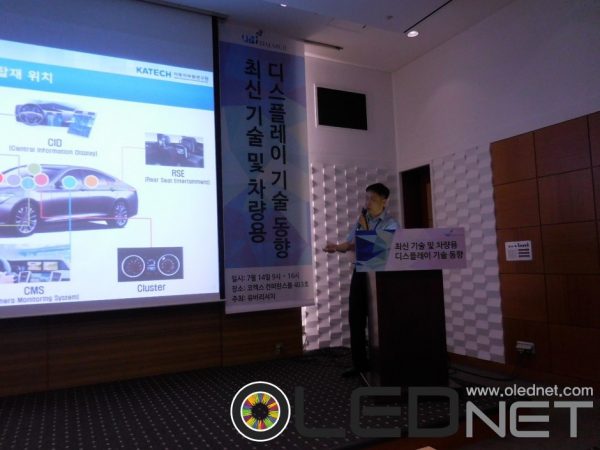
In the seminar, Sun-hong, Park, a senior researcher of automotive parts, said that “The attention to the display is increasing due to the importance of the visual intelligence, and its application will also grow because the OLED is able to easily realize the flexible deign and the transparent display.”
In addition, he expected that “The digitalization for the automotive will be lasting, and the China will take 50% and more of the worldwide consumption market for automotive in 2020, and the application of display including OLED will increase in accordance with the attributes of the Chinese who prefer colorful design.”
During the briefing of a car not having a side mirror which became an issue in recent, “The application of the OLED which has rapid response speed and wide viewing angle is highly likely to be employed. If it can just overcome the reliability, the OLED will be the best display for the automotive.”
In the other side, according to the “Automotive Display Report – application & market trend analysis and the market forecast” published by the UBI Research, it expected the OLED panel will be started in earnest applying to the cluster or CID of the automotive from 2018, and the automotive display is expected to grow about 17% annually, reaching around US$ 25,000 million by 2022. The AMOLED panel market among this will be account for about 20%.
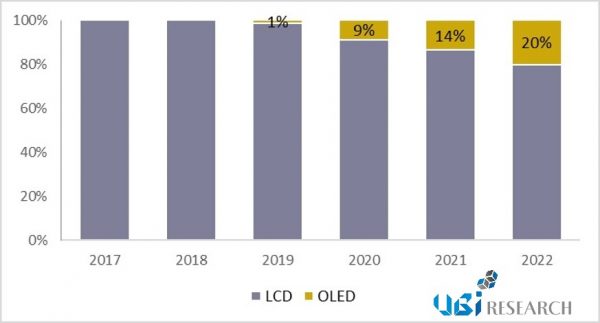
<Forecasting of the market share by the automotive display 2017~2022>
“While the existing OLED TV is focused on the image quality, the current OLED TV is not only picture quality but also covering any areas including the design and the sound quality.”
In the keynote address for the workshop of ‘the 12th Display National R&D Projects’ held on 5 July in Hoengseong, Gangwon-do, Soo-young, Yoon, a director of LG Display, introduced the advantages of OLED TV such as superior image quality, design freedom, and sound quality improvement including the capacity of the light and shade, and color implementation.
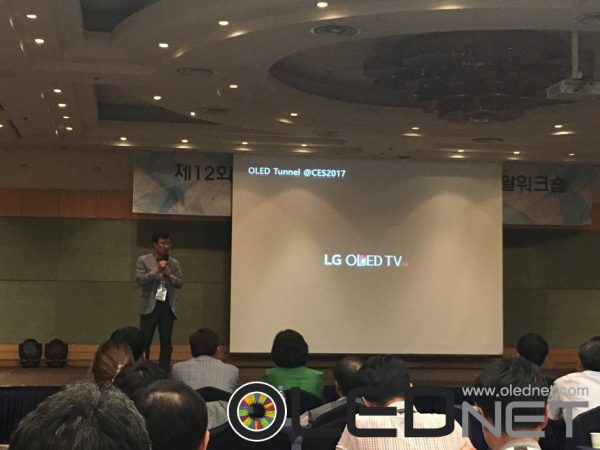
He said, “It is unlike LCD, OLED is the self-emitting, and be able to be controlled by a pixel unit, so that it is capable of expressing the perfect black, and implementing the unlimited contrast range. Therefore, OLED is the best display to express the stars or a bright moon in the darkness.” And also, he emphasized that “OLED TV is free to express the middle gradation through the precise color expressiveness, so that it is able to realize the vivid color as realistic.”
Subsequently, he introduced the wallpaper and CSO (crystal sound OLED) which attracted lots of attention in last CES 2017, “If the existing OLED TV is an image quality-oriented, the current OLED TV goes through any areas such as the design, sound quality but also the image quality. Especially, the embedded speaker methods are able to realize the high level of immersion, by agreeing the position of the mouth and the sound along with the effect of design advancement.”
A director, Soo-young, Yoon, also introduced the transparent flexible OLED which can implements the radius of curvature 80R, 40% penetration ratio, and 77-inch UHD, that developed for the commercialization, and mentioned that the transparent and flexible display will be a future display. He also said that they are on-going to develop the devices and materials for solution process, and it needs to be discovered the new application and new form factor.
Finally, he mentioned the P10 factory at Paju, “We expect to ultimately produce new OLED TV at P10 factory which plans to be completed by the end of this year through thorough preparation.”
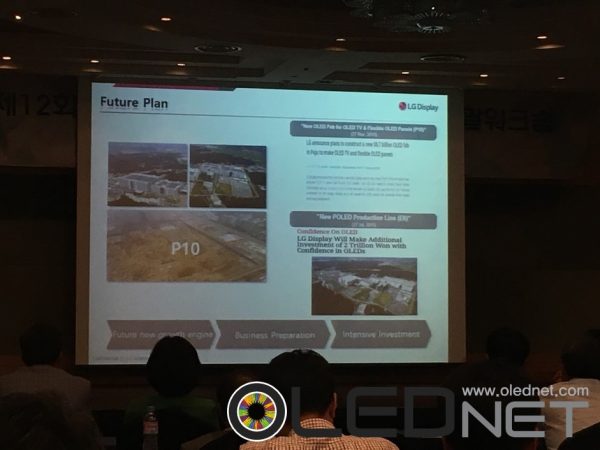
In the premium TV market in 2017 OLEDs seemed to catch up early with LG Electronics’ OLED TV sales volume growth and Sony’s OLED TV market gains. However, with the announcement of AUO, Taiwan’s leading LCD maker, that LCDs are more advantageous in the premium TV market than OLEDs, once again, competition between OLED TVs and LCD TVs is expected to intensify.
In the keynote session of SID 2017 held in Los Angeles, USA from May 22, AUO CEO Paul Peng made a presentation with the theme of “The warring states of display technologies” that LCDs would continue to outperform OLEDs in the premium TV market.
Paul Peng has three major claims that LCD is more dominant.
First is the performance that LCD is superior to OLED in terms of maximum size, peak brightness, ambient contrast ratio, color gamut, image sticking, and lifetime.
Second is the cost. In the black Friday in 2016, 65-inch HDR 4K narrow bezel LCD TV was US $ 1,099, while OLED was more than double with US $ 2,800.
Lastly, eco friendly. The industrial water used in the manufacturing process is used more for OLED manufacturing than LCD, and the power consumption of OLED is about twice that of LCD. The replacement cycle is 2 to 4 years for OLED, but LCD is 5 to 8 years which is more than twice as high as LCD, so is more environmentally friendly than OLED.
Since the launch of OLED TVs, there has been intense competition between LCD and OLED camps, but OLED market share continues to rise in the premium mobile market, and even in the premium TV market OLED seemed to be ahead of LCD. However, with AUO’s announcement in the keynote of SID 2017, the world’s largest display society, it is expected to intensify the fierce battle between OLED and LCD in the display industry.
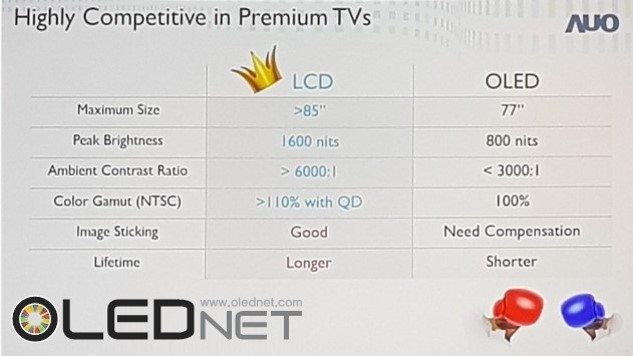
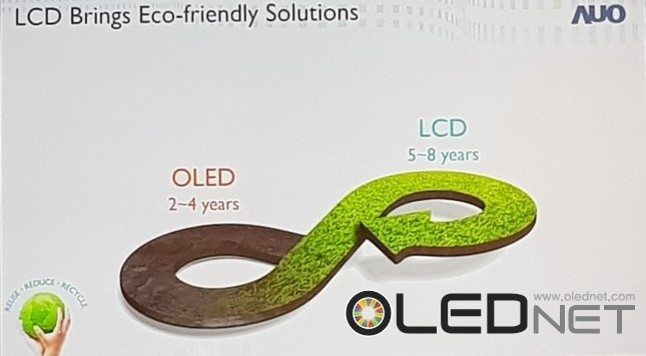

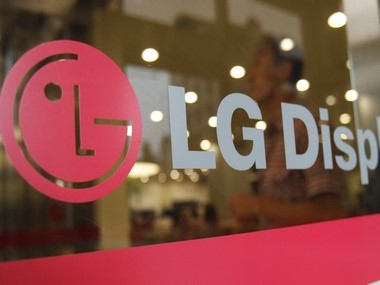
LG Display announced that it will concentrate 70% of CAPEX(investment cost for future profits) on large-sized OLED and POLED, and among them, the proportion of POLED will be higher than that of large OLED through the 2017 Q1 conference call held on April 26.
Kim, Sang Don, CFO of LG Display said “The specific size and timing of the investment is under review, but investing more than 70% of the investment in OLED remains unchanged.” Also revealed LG Display’s future investment direction by adding “Since OLED investment costs are high, we will deeply examine the confidence of our customers and the certainty of market demand, and will invest in a conservative position.”
LG Display said it will continue to secure LTPS-LCD competitiveness. Kim, Sang Don, CFO said ”We plan to switch the Gumi E5 line to POLED instead of LTPS-LCD in the second half of this year, but we think there still is demand for LTPS-LCD and opportunity for high-resolution smartphone manufacturing.”
For the LG Display’s plan for OLED Lighting business and OLED panel shipment, mentioned “OLED lighting will be produced about 15,000 sheets in the second half of 2017, and POLED will be mass-produced in Gumi E5 at the end of 2Q 2017.
For a plan for OLED TV production expansion, said “The reaction for OLED wall paper TV and Crystal Sound OLED released at CES 2017 in January this year, is better than expected in the TV market.” and mentioned “We expect OLED TV shipments to reach 300,000 units in 1Q and 500,000 units level in each quarter of the second half of this year.”
The forecast for ultra-large TV market in 2017, it is forecasted “LG OLED TV occupies an overwhelming share in ultra-large OLED TVs of 60 inches and above, and the ultra-large TV market is expected to grow continuously and record more than 30% of growth rate in the future.”
For the LG Display’s counterplan forward for the Chinese panel makers’ LCD technology, mentioned “Until 2020, it is concerned that the Chinese LCD panel makers are expected to improve their LCD technology and invest in Gen 10, however, LG Display’s IPS technology, consistent quality of mass production and stable supply chain are enough to overcome.”
Meanwhile, said that the sale proportion by product based on LG Display’s sales amount in Q1 this year were 43% for TV panels, 26% for mobile panels, 16% for notebooks and tablets, and 15% for monitors. Also, quarterly operating profit reached a record profit of 1.269 trillion won through continuous overall price increase trend of panel and the mix operation of profit-oriented products of high-resolution, high-end IT products and etc.
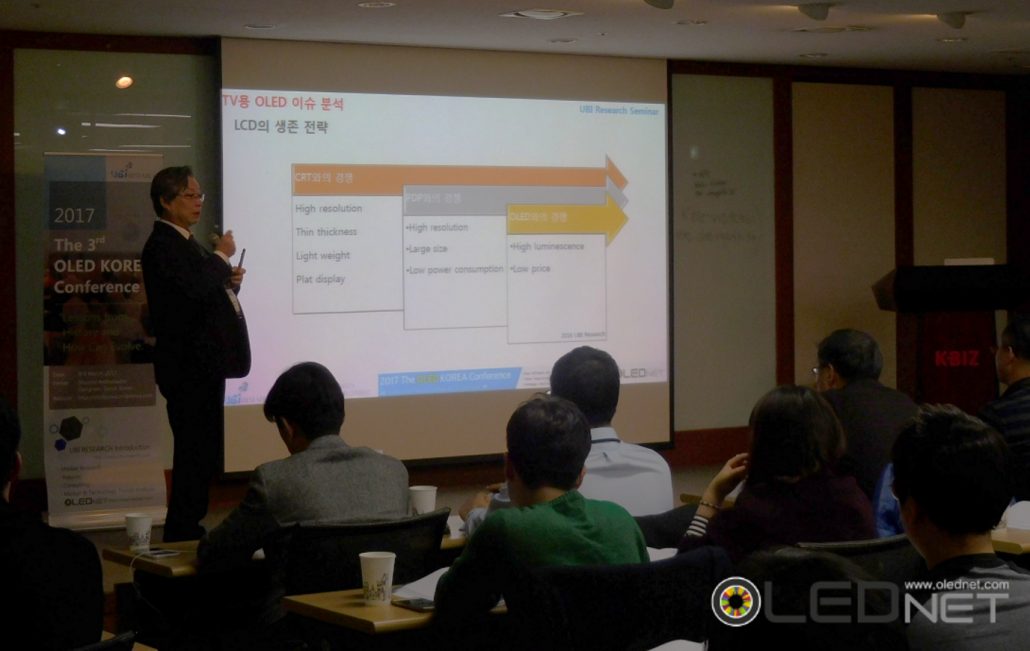
‘2016 OLED accounting seminar was held by Ubi industrial research on Dec 2nd in the Small& Medium Enterprise Hall. Lee, ChungHoon, the president of Ubi industrial research said, “OLED is leading a new paradigm in the display market, advancing a perfect black color and fast response rate compared to LCD. Most LCD manufacturers have introduced QD-LCD with the enhanced color reproduction, compared to the existing LCD. However, OLED is also in the evolution of display technology ”
LG electronics set up dark light at the booth in CES 2016; but later in IFA 2016 it displayed OLED TV, brightening the booth to show the confidence in luminance of OLED TV. Via CES 2016 and IFA 2016 the luminance has been improved from 600 nits to 800 nits, and next year OLED TV with higher than 1,000 nits will be launched.
The president Lee said, “In the current TV market, the unit price of OLED panel is triple the price of LCD and QD-LCD is double. If LG display reduces the OLED panel price, LCD manufacturers will be threatened due to the competitive pricing and technology of OLED panel.”
LCD manufacturers need to prepare marketing strategy for QD-LCD to be distinguished from OLED. Certainly there has been a market interest increased in QLED which seems, however, to be at a very early development stage like an embryo in the product life cycle. The soluble OLED will be introduced in the market earlier than QLED, the development of which prospectively takes at least 10years.
The primary issues of OLED TV can be summarized in three elements-size, price and luminance. The current OLED TV size is mainly 55”, but it is important to form a market for 65” and larger. The investment in Gen 10 line is necessary but has not been well established yet. As far as the price is concerned, if the ink jet technique is implemented in a new production line the price can be significantly reduced. The luminance can also be improved by 3-stack and top emission structure.
The shipping amount in 2016 is 390million, and will reach 1.5billion in 2020 in prospect. Flexible OLED panel will lead the high-end market while a rigid OLED panel for the mid-end market. The revenue will grow from 17trillion in 2016 to 60trillion in 2020. The estimate can be accomplished if Chinese manufacturers such as BOE, Tianma and GVO successfully advance and continue to grow in the market.
The current OLED market is growing in the mobile-oriented market, however, since 2018 TV will be stably settled and well established in the future.
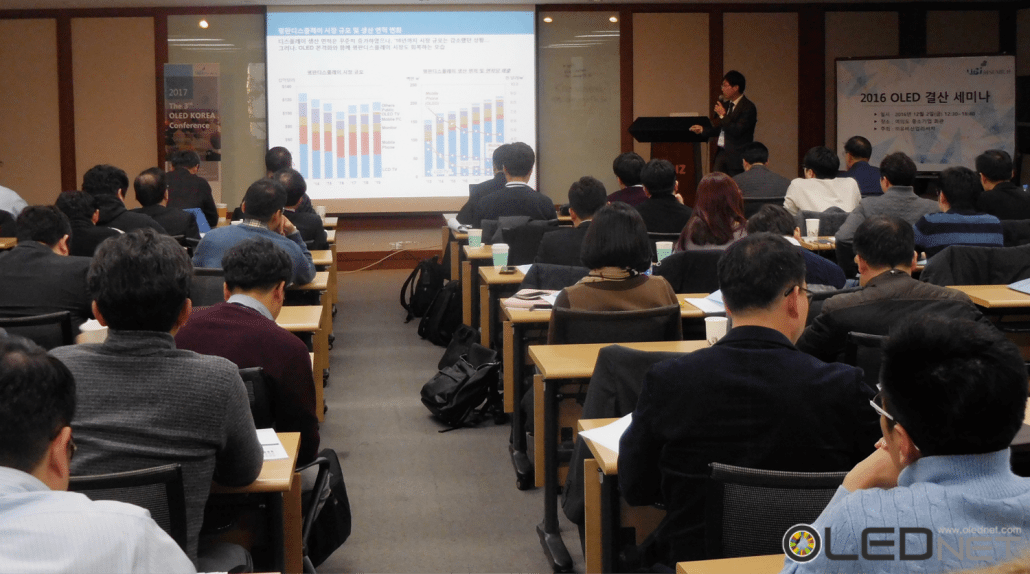
<Lee Woo-keun, a senior researcher at LG Economic Research Institute>
Lee Woo-keun, a senior researcher at LG Economic Research Institute, predicted that the year 2017 will be an important year to be able to emphasize the innovation of OLED to consumers, in the seminar for the 2016 OLED evaluation held at the Yeouido Small & Medium Business Center in Seoul, hosted by UbI Research on last December 2.
He added “LG is leading the OLED TV market in the premium TV market ahead of next year’s CES, but we will have to keep an eye on the impact of Sony’s joining” as one of the notable issues in large-sized OLED panels, and he continued “as there is still a fundamental expectation for Sony’s image quality among existing consumers, we will have to pay attention to what innovative appearance Sony’ OLED TVs will show and how they can appeal to consumers.
Referring to the adoption of OLED panels in Apple’s iPhone8 (tentative name) in the mobile phone market, as a small and medium issue, he said “it is important how to realize OLED display on Apple iphone 8, and how much impact it will have on consumers through this”. He said “if we could not show the innovation distinguishing it from existing LCDs despite adopting OLEDs, consumers’ expectations for OLEDs may be diminished,” emphasizing that it should draw meaningful responses to OLEDs from consumers’ perspective .
It is expected that Apple will launch iPhone applying flexible AMOLED panels in 2017, and Sony is also being confirmed to continuously review its entry into the OLED TV business. In 2017, it is expected that the number of set-makers launching OLED-applied products will increase more. In the situation that consumers are expecting a ‘completely new thing owned only by OLED products’, which is entirely different from existing LCD products, through various media reports and rumors, the year 2017 seems to be an important year to emphasize the innovation of OLED and to promote its merchantability.
At the 2016 IMID Business Forum held at COEX in Samseong-dong on October 26, 2016 LG Display managing director Kim Gwang-jin announced that the share of OLED TV overtook that of LCD in the North American premium market, and they will put more focus on the premium market.
LG Display managing director Kim Gwang-jin added “Larger than 65inch US$ 3,000 had a 53% market share and larger than 55inch US$ 2,000 had a 80% market share in the North American premium TV market in the first quarter of the year. And, the result indicates that consumers spend their money to buy premium TVs, so OLED TV is now successful in the premium TV market and they will continue to concentrate its energy on OLED TV of the premium market”.
He also said that the lifespan that has been pointed as one of the OLED TV’s problems guarantees more than 10 years of lifespan if it is used for 8 hours a day, compared to American TVs with 8 years of replacement period and Chinese TVs with 6 years of replacement period. With regard to image sticking, OLED TV has been upgraded by compensating circuit, sensing, and algorithm with no problem.
In addition, he expects to produce 900,000 this year and more than 1.5 million large-size OLED TV panels next year according to the next year’s market forecast, and create such various areas of markets as monitors and signage besides TV.
Meanwhile, this year LG Display made the third investment in large-size OLED panel production line, aiming to run it in the first half of 2017.
UBi RESEARCH held ‘An Analytical Seminar on OLED Market Entry Feasibility of QLED and Solution Process’ on the 14th at Seoul Small& Medium Business Center.
CEO Lee Chung-hoon of UBi REARCH said “OLEd TV will show 16.7% market share in 2016 at the world premium TV market, and lead premium TV market with 68.1% share in 2020.” and analyzed such like “LCD TV could not follow OLED TV performance excluding low price and high solution.”
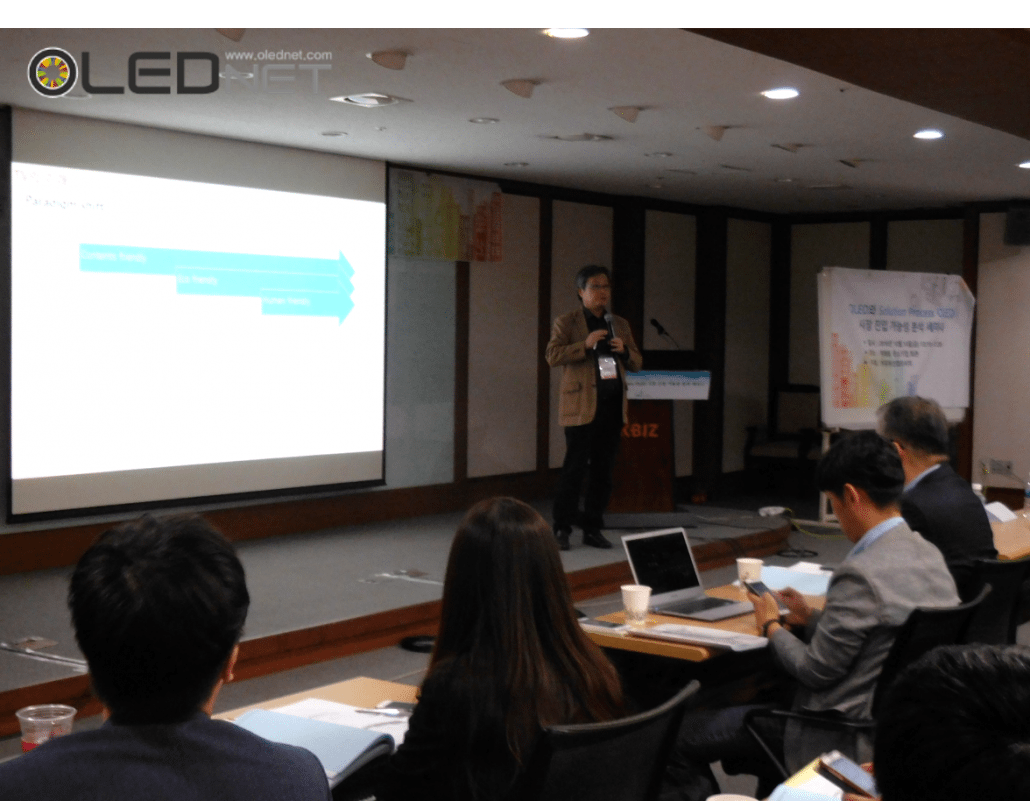
China is threating domestic LCD market in current wide TV market while displaying material superiority to LCD industry, and cost-effective rate of the wide TV is losing ground to Chinese products too. Thus, LG Display and LG Electronics did successful market entry after having equipped with competiveness in the premium market through OLED TV, and they are expediting mass-production investment and technical development aiming at dominating and popularizing premium TV market.
The most important factor in popularizing OLED TV is price. ASP (average sales price) of UHD OLED panel based on second quarter of 2016 is USD 720, and FHD OLED panel is approximately USD 450. It was expected that UHD OLED panel could lead TV market if it secured about USD 500.
Development to adopt solution process methods has been progressed in order to lower price of wide OLED panel in the industry, and QLED technology as an alternative of OLED TV is becoming an issue nowadays.
In relation with this, CEO Lee Chung-hoon forecasted like “As much as being closed to commercialization due to development of solution process OLED or QLED technology, WOLED technology becomes to be developed one step more, so market entry of solution process OLED and QLED will not be achieved easily. Specially, there are many technical issues in QLED which is considered as next OLED by Samsung Electronics, and 10 years of research will be required further.”
Also, he emphasized that the technology of being able to reduce cost vs. WOLED such as lessening layer numbers dramatically etc. should be developed in order to enter solution process OLED and market successfully, and the entry shall be made by targeting low-end market. In particular, he analyzed that WOLED would lead premium TV, and solution process QLED and QLED occupy the low-end market after 2020.
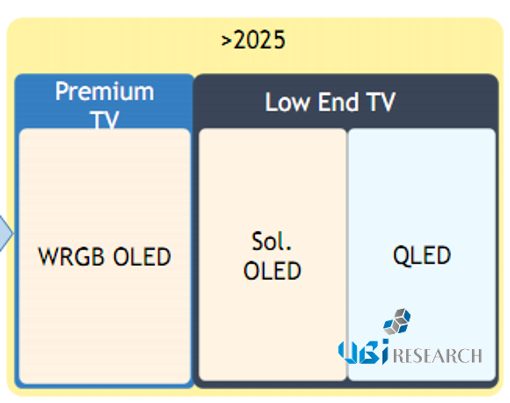
<TV Market Scenario after 2025 (Source: UBi RESEARCH)>
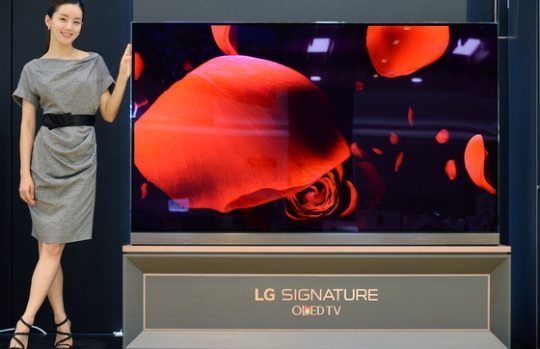
LG`s 77 inch OLED TV Picture Source = LG Elec.
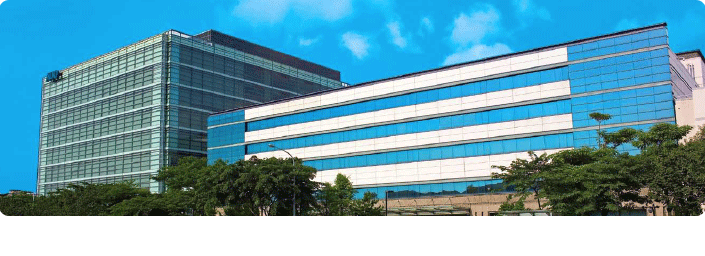
Taiwanese panel industry in recorded decreased small to medium size LCD panel shipment and increased shipment of 9 inch or bigger large size LCD panel. (Picture Source = AUO)
Hyunjoo Kang / jjoo@olednet.com
In Q2 2016, Taiwanese panel industry recorded decreased small to medium size LCD panel shipment and increased shipment of 9 inch or bigger large size panel.
According to DigiTimes, Taiwanese TFT-LCD panel companies shipped 58.38 million units of ≥ 9 inch panels in Q2 2016, an increase of 18.1% QoQ, and 0.8% increase YoY. The small to medium size panel shipment was 269.249 million units, a decrease of 0.5% QoQ, and 6.3% decrease YoY.
In terms of small to medium size, ≤ 9 inch, Chunghwa Picture Tubes (CPT) led the shipment volume with 100.56 million units, and HannStar Display followed with 67.892 million units in Q2. For LCD panels ≥ 9 inch, AUO led the Taiwanese market with Q2 shipment of 27.11 million units. Of these 7.176 million units are for TV, and the rest are for notebook, monitor, and tablet. Following AUO, Innolux recorded 27.09 million units of shipment. Of these 10.72 million units are for TV, and the rest are for notebook, monitor, and tablet.
According to companies’ recent Q2 performance announcement, key Taiwanese LCD companies, including AUO and Innolux, reported decreased business profit. AUO reported TWD 80,000 million in Q2 sales, a 13% fall YoY, and TWD 116 million in business profit, approximately 98% decrease YoY. Innolux showed TWD 66,800 million in Q2 sales, decrease of approximately 29%, and business loss of TWD 3,039 million.
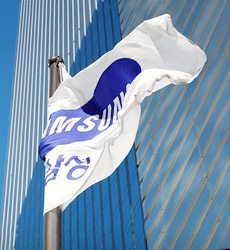
Source = Samsung
Samsung Electronics today announced financial results for the second quarter ended June 30, 2016. Samsung’s revenue for the quarter was KRW 50.94 trillion, an increase of KRW 2.40 trillion YOY, while operating profit for the quarter was KRW 8.14 trillion, an increase of KRW 1.24 trillion YOY.
The second quarter saw significant earnings growth led by strong performance both in the set and component businesses. Overall earnings of the set business improved YOY as well as QOQ due to the continuous sales increase of premium products.
The IT & Mobile Communications (IM) Division saw substantial earnings improvement led by expanded sales of flagship products such as the Galaxy S7 and S7 edge. A streamlined mid-to low-end smartphone lineup also contributed to improved profitability. Operating profit for the IM Division was KRW 4.32 trillion.
The Consumer Electronics (CE) Division achieved significant earnings growth YOY led by strong sales of its premium lineup such as SUHD TVs, Chef Collection Refrigerator, AddWash washer and newly launched air conditioner.
The component business achieved solid performance although overall earnings decreased YOY due to ASP declines in the industry. Earnings for the Display Panel segment improved QOQ led by increased OLED capacity utilization and stabilized LCD panel yields. Demand for semiconductors for mobile and SSD increased and the company achieved solid growth with a competitive edge in differentiated products, including 20-nanometer DRAM, V-NAND and 14-nanometer mobile AP.
The company estimated that the stronger Korean won against major currencies in the second quarter negatively impacted operating profit by approximately KRW 0.3 trillion, reflected mainly in the component business earnings.
Looking ahead to the second half of 2016, the company expects its solid performance to continue compared to the first half, mainly driven by earnings increase in the component business due to sales growth in high value-added products and stable demand and supply conditions. The set business is expected to continue its stable earnings while the IM Division expects marketing expenditure to increase.
In the third quarter, the company expects the component business to maintain its solid performance due to improved demand and supply conditions for memory chips and LCD panels and stable earnings for OLED and System LSI. For the set business, the company forecasts marketing expenditure for the IM business to increase mainly due to a new flagship product launch and fierce competition in the industry. Meanwhile, weak seasonality is likely to impact the CE business.
Capital expenditure (CAPEX) for the second quarter was KRW 4.2 trillion, which includes KRW 2 trillion for the Semiconductor business and KRW 1.6 trillion for the Display Panel business. The accumulated total CAPEX for the first half was KRW 8.8 trillion.
The annual plan for CAPEX has not yet been confirmed but is projected to increase slightly compared to last year. This year’s CAPEX will be concentrated on OLED and V-NAND capacity as the company sees strong market demand for OLED panels for smartphones and V-NAND SSD.
The Semiconductor business posted KRW 12 trillion in consolidated revenue and KRW 2.64 trillion in operating profit for the quarter.
The memory business enjoyed solid growth in demand in the second quarter. Orders for high-density NAND and DRAM products contributed to solid earnings QOQ. This was coupled by a reduction in cost from continuous process migration.
In NAND, shipments of SSD remained strong in the quarter, as enterprise companies increasingly made the transition from HDD to SSD so as to reduce total cost of ownership (TCO). Orders for high-density mobile storage products over 32GB also helped drive sales, mainly due to the expanded adoption by Chinese companies. Samsung actively responded to orders for high-density mobile products over 64GB and enterprise SSD over 4TB and increased supply of the industry’s first 48-layer V-NAND.
In DRAM, demand climbed QOQ as smartphone manufacturers bought more high-density mobile DRAM and demand for high-density products increased following the launch of a new server platform.
A supply imbalance of some applications led to greater demand for Samsung’s 20-nanometer high-density, high value-added mobile and server products.
Looking ahead, for NAND, increased adoption of high-density products and strong seasonality will further drive demand growth in the second half. Growth in high-density, premium SSD products will continue, and the launch of new products by smartphone manufacturers is expected to raise demand for mobile storage. However, supply and demand will be tighter in the second half, due to soft industry supply growth.
For DRAM, the launch of new smartphones and the increasing adoption of 6GB memory chips in high-end smartphones will spur shipments of mobile DRAM in the second half. Shipments of high-density server products will be strong, as more data centers make the transition to a new server platform.
The System LSI business saw gains QOQ, thanks to stronger demand for 14-nanometer mobile AP in premium smartphones and increased sales of high megapixel image sensors. In the second half, increased sales of mid- to low-end mobile AP and LSI products are expected to provide a stable revenue stream.
The Display Panel segment posted KRW 6.42 trillion in consolidated revenue and KRW 0.14 trillion in operating profit for the quarter driven by increased shipments of OLED panels and enhanced yields for new LCD TV panel production technology.
For the OLED business, second quarter earnings improved QOQ due to healthy sales of flagship smartphones and increased demand for flexible panels. High fab utilization rates with the help of an expanded mid to low-end product portfolio also contributed to improved earnings.
For the LCD business, the second quarter saw a continuation of QOQ growth under a gradual recovery in the supply-demand balance. The company was able to achieve growth thanks to improved yields for new TV panel production technology as well as expanded TV sales particularly for large-sized UHD panels.
Looking ahead to the second half, the OLED business, Samsung expects demand for OLED panels to rise despite a likely slowdown in the smartphone market. To remain competitive, the company plans to actively address customer demand and reinforce profitability by expanding the proportion of high value-added products such as flexible and high-resolution displays. Samsung will also seek to secure supply capacity according to market demand while expanding its customer base and new applications.
As for the second-half outlook for the LCD industry, Samsung expects supply and demand to improve thanks to increased demand under strong seasonality as well as continuous UHD TV market growth and size migration towards larger screens. In response, the company will focus on enhancing profitability by improving cost competitiveness and expanding its portfolio to high value-added products including ultra-large size, high-resolution and curved panels.
The IM Division posted KRW 26.56 trillion in consolidated revenue and KRW 4.32 trillion in operating profit for the quarter.
Samsung’s earnings improved QOQ thanks to strong sales of its flagship Galaxy S7 and S7 edge smartphones. Additionally the company achieved growth in the second quarter by maintaining the profitability of mid- to low-end models, such as the Galaxy A and J series, and improving the product mix by raising the sales proportion of the Galaxy S7 edge to over 50 percent.
Demand for smartphones and tablets in the second half is forecast to increase, however, market competition is expected to strengthen as other companies release new mobile devices. Despite this outlook, Samsung will focus on YOY earnings increase by strengthening its high-end line-up and maintaining solid profitability of mid to low-end products.
Looking into the third quarter, the release of a new large-screen flagship smartphone will help to maintain solid sales of high-end smartphones led by the Galaxy S7 and S7 edge. Samsung will also focus on expanding smartphone sales including this year’s new Galaxy A and J series and the debut of the Galaxy C series exclusively for the China market.
Samsung will focus on increasing smartphone sales under strong seasonality with the launch of a new model, while expecting marketing expenses to increase QOQ due to seasonality.
As for the Networks business, earnings improved due to increased LTE investment of major carriers in the second quarter.
The Consumer Electronics Division – encompassing the Visual Display (VD), Digital Appliances (DA), Printing Solutions and Health & Medical Equipment (HME) businesses – posted KRW 11.55 trillion in consolidated revenue and KRW 1.03 trillion in operating profit for the quarter.
In the second quarter, global TV demand remained flat YOY due to sluggish economic conditions in major emerging markets that offset the growth experienced in developed markets. Amid these challenging conditions, Samsung achieved solid YOY earnings by successfully launching new products, including SUHD TVs, and increasing sales of premium products on the back of global sporting events.
For the appliances business in the second quarter, although growth momentum continued in North America, global demand declined YOY due to slower growth in China and the impact from the economic slowdown in emerging markets. Despite these circumstances, earnings improved from the same period of the previous year thanks to increased sales of premium products such as the Chef Collection refrigerator and the AddWash and activ dualwash™ washing machines.
Looking ahead to the second half, TV demand is expected to decline YOY due to weakened demand in Europe and a prolonged economic slowdown in emerging markets. In response, Samsung will focus on improving profitability and increasing sales through collaborations with local channel partners and through region-specific promotions. To reinforce its leadership in the premium TV segment, the company will also seek to grow sales of its premium SUHD TV line-up, particularly products featuring its Quantum Dot technology.
Concerning the outlook for appliances in the second half, market growth is expected to be limited due to the aforementioned concerns in Europe and emerging markets. Despite these conditions, Samsung will actively seek opportunities to counter the challenging market dynamics by launching innovative products that offer superior consumer experiences. The company also plans to achieve further growth by enhancing its B2B business in this sector, particularly for built-in kitchens and system air conditioners.

2016-2020, global Gen8 complementary investment ( LCD → OLED ) is expected to be total USD 6,674 million.
Hyunjoo Kang / jjoo@olednet.com
For the next 5 years, 2016-2020, global Gen8 (8G) complementary investment ( LCD → OLED ) is expected to be total USD 6,674 million.
According to 2016 OLED Manufacturing Equipment Annual Report, recently published by UBI Research, Korea’s 8G complementary investment in 2016-2020 is estimated to be USD 5,400 million, 81% of the global USD 6,674 million. Particularly, complementary investment for large area LCD line to OLED is expected to be actively carried out centering around LG Display.
China is estimated to actively operate new large are LCD lines from 2016. To respond to this move, Korean panel companies are expected to transform 8G a-Si LCD lines located in Korea to OLED line from 2016.
To respond with LCD, China’s supply offensive and price competitiveness are too strong. As such, the situation calls for concentrated efforts in OLED.
Gen8 LCD line became the object of complementary investment as it can be easily converted to OLED compared to small-to-medium size LCD line. 8G LCD line’s a-Si TFT can be turned into oxide TFT used in Gen8 OLED line cost effectively.
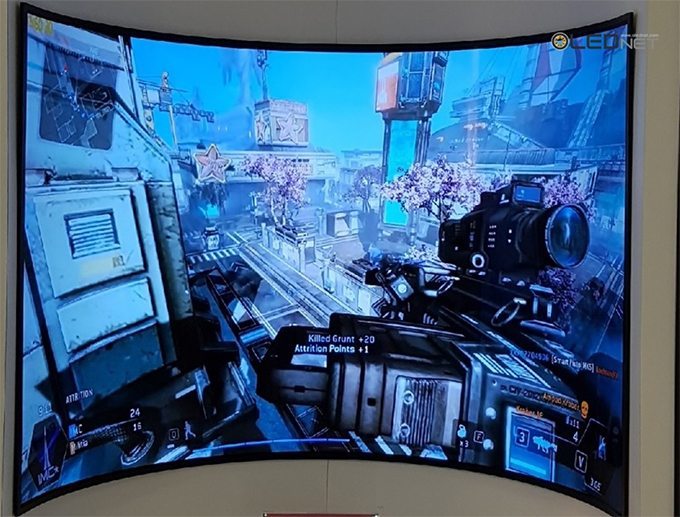
LGD`s 65“ OLED TV Panel

a Slide from JDI Hiroyuki Ohshima CTO`s Keynote (San Francisco =OLEDNET)
Hyunjoo Kang / jjoo@olednet.com
CTO of JDI , Hiroyuki Ohshima, estimated that the display will evolve to flexible and human friendly, and emphasized that LCD is not suitable for flexible
During his keynote session in SID 2016 (22-27 May), Ohshima discussed the future of display. He explained that the display will evolve to System Integrated Display that combines different technologies and toward flexible.
Display is expected to become more interactive with human body. Beyond touching the screen with fingers, biological signals will be recognized such as heartbeat, eye gaze, fingerprint, and palm print. Through these, display will evolve into an input device that moves deeper into people’s lives.
For these to become a reality, Ohshima explained that diverse technologies such as touch, recognition, security, health care function, pen input need to be applied to the display. He stressed that display is heading toward flexible and noted LCD’s limitation regarding this issue.
Ohshima told the attendees that as LCD requires backlight and glass substrate is used, it is not suitable to actualize flexible panel. For OLED, it is expected to move forward to flexible and foldable exceeding ultra-thin and curved. However, he added that OLED still has several issues that need to solved including not being able to follow LCD in terms of pixel density.
Hyunjoo Kang / jjoo@olednet.com
Samsung Electronics announced today that it has sold more than one million curved monitor products worldwide. The global display provider introduced its first curved LED monitor – the 27-inch, 4000R (curvature radius of 4,000 mm) SD590C model – in September 2014, and since has expanded its line-up to include several additional curved monitors. As a result, Samsung currently accounts for more than 85 percent of all global curved monitor sales (Source: International Data Corporation (IDC), 2015 Q4 worldwide sales results for 15”~34” curved monitors).
Designed to match the natural shape of the human eye, Samsung’s curved monitors feature uniform center-to-edge viewing distances to create a more comfortable and immersive viewing experience conducive to long-term use. Combined with extra-wide viewing angles and enhanced contrast ratios, these curved displays are ideal for gamers and at-home entertainment users seeking realistic, distraction-free picture quality. As a result, Samsung has capitalized on growing demand from these audiences (many of whom employ several monitors during game play or content viewing).
“Since the launch of our first curved monitor in 2014, we’ve seen this technology evolve to become an industry standard that gaming and entertainment viewers expect,” said Seog-gi Kim, Senior Vice President, Visual Display Business, Samsung Electronics. “As curved monitors continue to grow in popularity, we welcome the challenge of further advancing our displays’ design and capabilities to drive new levels of viewer engagement and comfort. We are happy to have reached one million sales for our curved monitors so far, and we look forward to delivering new curved technology innovation in the coming years.”
Samsung’s curved monitor design refinement includes the introduction of a sharper curve with each new model while maintaining a consistently sleek and stylish presentation. In January 2015, Samsung released its second curved monitor, the 34-inch SE790C, featuring 3000R curvature. The company’s latest curved offerings – the CF591 (27-inch model) and CF390 (23.5- and 27-inch models) – further expand visual possibilities with an industry-leading 1800R composition.
Samsung Electronics reported a third-quarter earnings through a conference call on October 29 local time. Samsung Display’s Chang Hoon Lee revealed that OLED panel’s production cost can now compete against LCD and the company has plans to increase the external transaction ratio by more than 30% of yield.
The display business department was expected to have a difficult time in Q3 2015 due to the smartphone market’s slowdown of growth and latecomers’ competitiveness increase. However, with the key customer base’s release of new products and increase of new clientele, and secured operation ratio, the performance results improved.
Lee also revealed 2016 strategy of increasing the low-to-medium priced products, expanding the new market, diversifying products, and procuring transaction base. Lee also added that Samsung will prepare to secure new growth power through transparent, mirror, HUD, and automotive display development via technology leadership in areas such as flexible OLED.
It was also announced that the additional installation of OLED line will be decided after examining the market status. A3 line has been in operation since April. Supply competitiveness will be strengthened through complementary investment for existing line.
Samsung Electronics recorded a 6% increase compared to the previous quarter with revenue of USD 47 billion. With the help of currency exchange rate, business profit showed approximately USD455 million compared to the previous quarter with USD 6.7 billion.
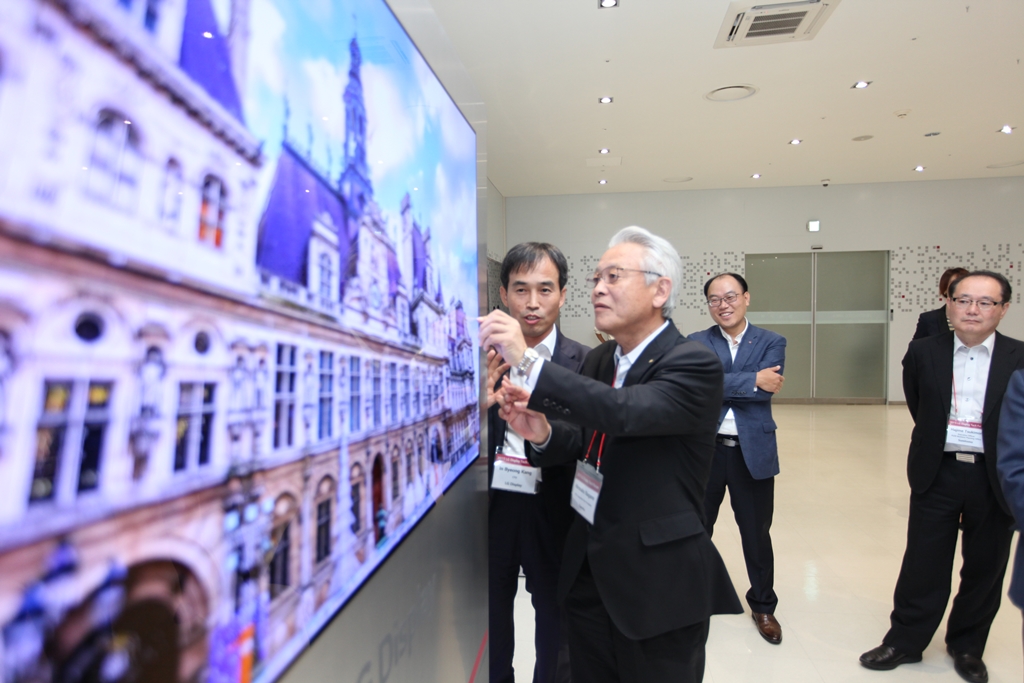
Source : LG Display
LG Display set out to discover new technology through open innovation in collaboration with other companies.
On September 15, LG Display invited top global display material and component companies to Paju factory and opened 2015 LG Display Tech Forum. The invited companies included Merck, Asahi Glass, and Sumitomo.
Under the heading of ‘OLED, New Opportunity and Challenge’, 13 key collaborating companies in material, process, glass, and circuitry sectors participated. They promised to share market trend, and LG Display’s OLED and LCD technology development direction and cooperate regarding future technology.
LG Display increased emphasis on OLED; LG Display revealed detailed business strategy for large and small size OLED, and discussed technology and products that should be developed together in collaboration with companies in each stage.
Additionally, LG Display newly established Technology Innovation Award for collaborating companies that contributed to LG Display’s product improvement with innovative technology. The award was presented to Asahi Glass for developing glass light guide panel used in thin panel actualization, and display material companies Merck and Nitto Denko.
LG Display’s CEO Han Sang-beom explained that LG Display could pave the way for OLED with world’s first technology due to much effort and enthusiastic corporation from R&D partners. He also entreated each company to continue to change and evolve through their own R&D competitiveness and creativity and lead the future display market.
Recent Samsung Electronics and LG Electronics’ TV and smartphone performance results are causing experts to be concerned over degrowth.
The axis that is centering Korean industry is dependent on these 2 companies and Hyundai Motor Company. In the 20th century when technology skills were lacking, Korean government and these 3 companies closely cooperated and coordinated product development and market cultivation. The low value of KRW invigorated the 3 companies’ export business. Strong government support allowed development of products that could compete against Japanese products occupying the international market. The potential that allowed the companies to overtake Japanese firms that were dominating electronics industry and increase the international market share was based on Korean government’s diverse interest and enthusiastic backing.
Japan’s display industry collapsed due to several reasons. Their pride that that latecomers including Korea will not be able to catch up to their technology, the discontinuation of investment by overlooking the need of the 21st century of information for display market, and the disregard of latecomers’ price competitiveness can be attributed to the collapse.
Korean display companies gave up on Gen10 investment in LCD business and began localization in China though establishing Gen8 LCD factory in China. However, Chinse display companies, with the backing of their government in large scale, continue to invest despite the deficit.
If BOE’s Gen10.5 LCD factory is complete, China will lead the global industry in terms of yield, and overtake Korea through China’s domestic market and price competitiveness. Now there are only 2 years left. It is only a question of time before Korea’s LCD industry falls apart.
The only thing that is left for Korean display industry is OLED. As Korean display industry plays an important role in Korean economy, the decline of display industry will have direct impact on employment, export, and domestic market.
However, Korean government is currently ignoring display industry. LCD and OLED have been excluded from WTO’s tariff elimination. China, which is rapidly becoming a new contender in display industry, has agreed with the U.S. to exclude LCD and OLED advocating protection of Chinese market and industry, and other countries followed. China is adding 5% tax for 32inch products or larger; Samsung Display and LG Display are operating LCD factories in China in order to be exempt. The labor force is moving away from Korea to China. Korea’s Ministry of Trade, Industry and Energy is overlooking the importance of Korea’s display industry.
To make matters worse, Korean government has no tax regarding manufacturing equipment. When display companies import expensive manufacturing equipment, no tax is added. Recently, due to a low exchange rate of the yen, Japanese companies’ price competitiveness is 1.5 times higher than several years ago. At a time when Korean manufacturing equipment companies are losing heavily in the competition against Japanese, Korean market is actually giving up the market to Japanese companies.
For example, if Samsung Display and LG Display have saved 10,000,000 USD on the purchase of manufacturing equipment, the result is Korean companies’ loss of 100,000,000 USD. Although 10,000,000 USD is a large amount of money to Samsung Display and LG Display, the consequential loss of 100,000,000 USD for Korean manufacturing equipment market is even more immense.
The Korean display ecosystem that has been carefully established is being destroyed by its own government.
Although Korean government is paying lip service to build strong small and medium-sized businesses, in actuality, it is giving small amount of money to large companies and continuing to ignore smaller Korean manufacturing equipment companies. For the future of the smaller Korean manufacturing equipment companies struggling against the weak yen, a system of where they can at the very least survive in domestic market is needed.
Job creation for the young engineers requires more consideration for small and medium-sized businesses rather than large companies that can thrive without any help.
Dr Choong Hoon Yi, UBI Research Chief Analyst, ubiyi@ubiresearch.co.kr
Korean TV industry, according to recent reports by media, is showing a red light not being able to escape the deficit structure.
Samsung Electronics and LG Electronics possess high market share in costly premium TV market. However, in 30inch grade market, the two companies struggle against economically priced sets. In order to maintain sales, Samsung Elec. and LG Elec. are managing diverse product portfolio but business profit keep falling. Due to this, LCD panel stocks produced by Samsung Display and LG Display are steadily increasing.
LCD panel business is sinking into a pit.
What is the reason that Korea’s LCD TV and LCD business values can only become worse?
This can be forecast from looking at Japan’s TV and LCD business. Until the early 2000s, Japan was one of the leaders in electronics. However, Japan’s TV business is gradually dying out. Japan’s leading companies, Sony and Panasonic’s TV business began to be deteriorate because of Korean mid-low price products. In succession, Sony ended up spinning off the TV business, and Panasonic stopped TV business other than for domestic supply. Korean TV companies began to dominate the market. However, only a few years since then, Korean TV industry is losing commercial value, pushed aside by mid-low price products manufactured by China and others.
Second is display investment. As Japanese TV industry began to crumble, Japanese display companies had no choice but to stop the investment. The companies could not see a way to make profit through investment even if TV market grew as client companies’ panel purchasing power fell. Korea is the same. Samsung Elec. and LG Elec.’s TV business profitability deterioration led toward Samsung Display and LG Display’s halting the investment. On the other hand, Chinse display companies began Gen10.5 line investment. TV industry relies on assembly business and business network and therefore initial investment cost is low. In comparison, display industry is high risk as it requires large scale investment from early stages. If the business profit falls without investment cost return, companies face great loss and business closure is also not easy.
The third reason that Japanese TV companies are dying out is because they could not produce premium TV. Sony, which lost its competitiveness in LCD TV, tried to strengthen its market leadership through 4K TV. However, the brand value was already down and with the lack of marketing value, Sony easily gave up the market to companies in pursuit such as Samsung Elec. and LG Elec. LCD TV already had no difference in quality whether it was produced by a Korean or Japanese company, and brand value order had switched. LCD TV quality produced by Chinese companies is already reached the top. They are no longer companies who produce cheaper knockoffs. Furthermore, LCD panel production technology of Korea, Japan, Taiwan, and China can now be deemed equal.
The final reason that stops Japanese TV business from securing market is that they failed to suggest differentiation point in premium TV. Fundamentally, differentiation is not possible for LCD TV. The biggest differentiation factors in the current TV market are picture quality and design. Any company can produce thin LCD TV and curved LCD TV. Panel size, resolution, and QD-LED using color gamut that LCD can actualize can no longer be differentiated technology. The difference of LCD panel and TV manufacturing technology between Korea, Japan, Taiwan, and China is already within a year. No matter what kind of product is released, market control has one year of expiration period. Considering the promotion period required in the market is approximately 6 months, the period where profit can be made is shortened even further.
So what is the solution for the Korean TV industry to survive?
As I have mentioned dozens of times for several years, what is left is OLED TV. What LCD cannot do in terms of picture quality and design, with OLED it is possible. Therefore, only the non-LCD products can enjoy the key factors of differentiation in premium TV market.
Existing premium TV is IPTV, a market that Japanese TV companies have been pursuing since early 2000s. Internet connection is possible through TV and allows for exchange of information in both directions. The basic concept of IPTV is watching TV while searching the information on TV via internet. But how useful is this concept at present? The usefulness of IPTV is becoming increasingly low as smartphone is used to search information, use the internet, and even watch TV. With no reason to use the internet via TV, TV companies should seriously consider whether TV with high white brightness is really needed. Rather than white TV with high brightness, it is time to place more importance in the functions of the TV itself. TV screen only uses 20-30% of full white brightness. Films, with outdoor shooting, falls under 20%, and for contents shot at night, black is more important.
Considering ‘blackness’ and design, anyone can find where the solution lies. If the foolish notion of trying to make OLED as bright as LCD is abandoned, there is hope.
UBI RESEARCH / CEO:Choong Hoon Yi / Business License Registration Number 220-87-44660
ADDRESS: A-1901, Samho Moolsan Bldg, 83, Nonhyeon-ro, Seocho-gu, Seoul, Republic of Korea (Zip) 06775 TEL:+82-2-577-4390 / E-MAIL:marketing@ubiresearch.com
